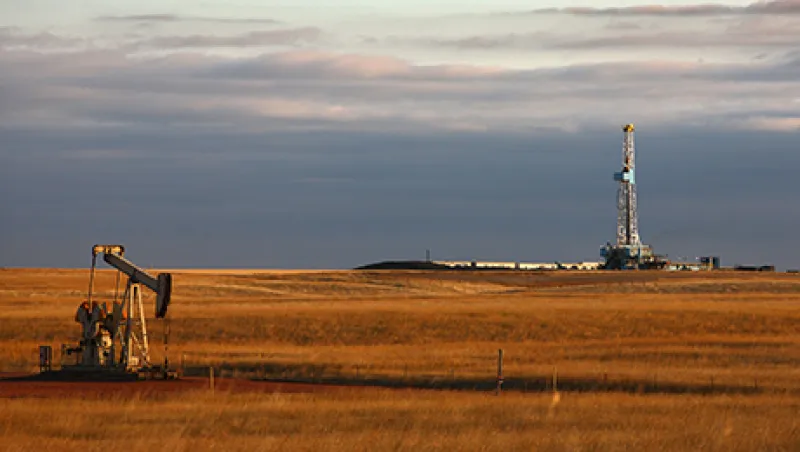Ask someone about the 1970s — regardless of whether the person was born yet — and a few answers invariably follow: fashions crafted out of polyester, music from funk and psychedelic rock to disco and punk. And on the geopolitical front, well, there was the energy crisis — or two, to be exact, in 1973 and 1979. One legacy of that era’s energy woes was a U.S. ban on domestic crude oil exports to all countries except Canada. The ban has been in place ever since, even during an oil glut spurred in part by energy conservation during the 1980s.
The U.S. may be facing another energy glut. This time, it’s because of vast new reserves from domestic oil shale production and hydrofracking. Tapping oil in the Bakken shale formation, for example, which lies beneath much of the northern Great Plains, has rendered North Dakota an emerging petro-market on the prairie and is helping to put the U.S. on pace to be the world’s largest energy producer by the end of 2016. The phrase “Export U.S. oil” might not be a unanimous cry yet from voter-wary politicians, but it’s music to the ears of energy producers seeking new customer bases. On June 24 the U.S. Department of Commerce’s Bureau of Industry and Security handed down a decision that pleased those producers by suggesting that the ’70s ban on exports might finally be lifted.
The ruling made the front page of the Wall Street Journal, and in reaction light sweet oil prices shot up above $107 a barrel for August 2014 delivery, then fell to the $102-per-barrel range.
Still, on the face of it, Commerce’s decision is not the monumental shift energy producers have hoped for. The ruling allows two companies, Pioneer Natural Resources and Enterprise Products Partners, licenses to export lease condensate, a specific petroleum product — and only if the condensate has been processed in a distillation tower. Lease condensate is an ultralight oil that is barely processed and is chemically different from heavier crude oil. If during production of natural gas, raw gas is cooled beyond its hydrocarbon dew point, it produces condensate, like dew on the grass. Lease condensates specifically come from crude oil wells, which can also yield gas that is either dissolved in oil or exists in separate, adjoining deposits. Before the Commerce decision, condensates produced at U.S. gas plants, known as plant condensates, were already allowed to be freely exported.
Commerce’s decision effectively exempts distilled lease condensate from the ban by reclassifying it from a crude product to a refined one, though it doesn’t have to pass through a conventional oil refinery. Nomenclature aside, the move triggered speculation that it might signal a wider intention to lift the larger export ban, and raised questions about how investors should respond.
Investors have already interpreted the change in wording, however minute, as a sign that politicians might be moving to lift the crude export ban. During the week of the Commerce decision, traders sold off shares in oil refining companies, including Phillips 66, Tesoro Corp. and Valero Energy Corp. New U.S. shale production is forcing more oil into the market, and refiners have been able to buy at lower prices, boosting profit margins. If the crude export ban were to be lifted outright, producers would not have to sell into a saturated market, and refiners might have to pay more.
Adam Wise, who oversees a $6 billion portfolio of oil and gas investments for John Hancock Financial Services in Boston, says the direct impact is limited to condensates and that there are no other forms of crude oil that could be reclassified based just on how the export ban is interpreted. “Ending the crude export ban could be an act of Congress or a presidential order, but chasing rulings on the existing regulations is only going to change things on the fringes,” he says.
Farther up the production line, regulatory uncertainty may stanch investment needed to transport and process new shale output. Possible losers from the move on lease condensates include builders of seven new condensate splitters, all located on the Texas Gulf Coast. These are smaller, cheaper facilities that fall between conventional oil refineries and the stabilizers now sufficient to create an exportable condensate.
With regulatory variables so prominent, Wise favors a hedged and diversified portfolio of energy assets on the assumption that if regulations create losers in one area, they will be making winners in others. That could mean equity investments in integrated producers with a number of divisions, or spreading direct investments across a variety of projects.
If the U.S. does take a more definitive stance on oil exports, when might that happen? Any lifting of the ban would be likely only after the November midterm elections. The U.S. remains a net oil importer, and voters often associate U.S. foreign policy in the Middle East with ensuring a secure energy supply. Energy secretary Ernest Moniz has said, however, that the government is studying the issue and in December called the export ban a dated policy in need of reevaluation. Says Charles Ebinger, director of the Energy Security Initiative at the Brookings Institution in Washington: “People like Secretary Moniz realize that by late 2015 or early 2016, the glut could get quite substantial. That could drive down prices and curtail exploration and production.”
Get more on macro.






